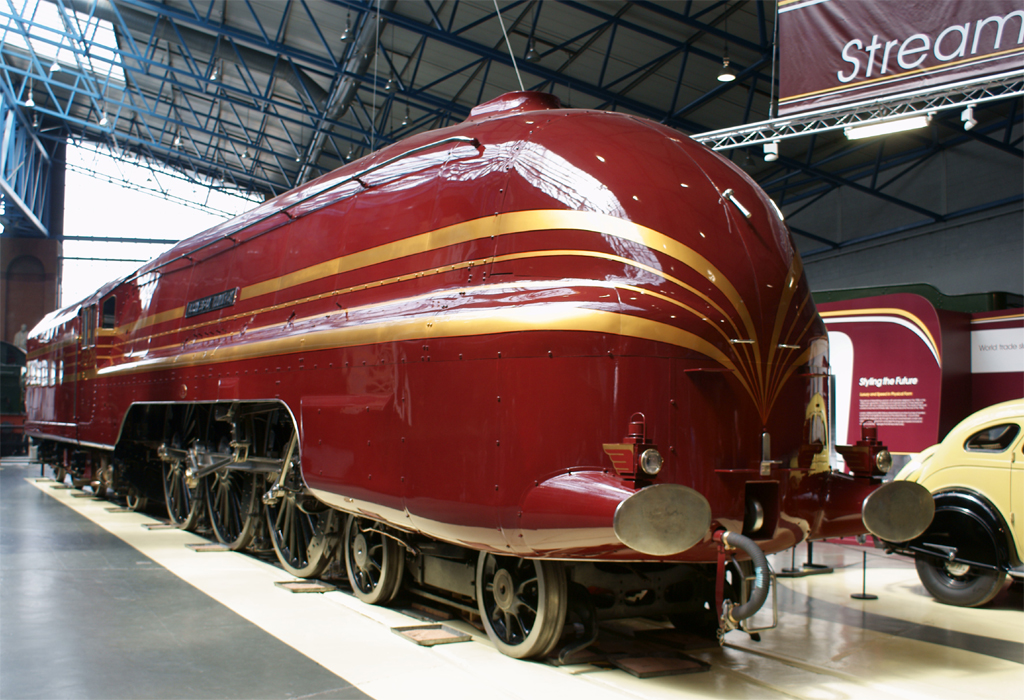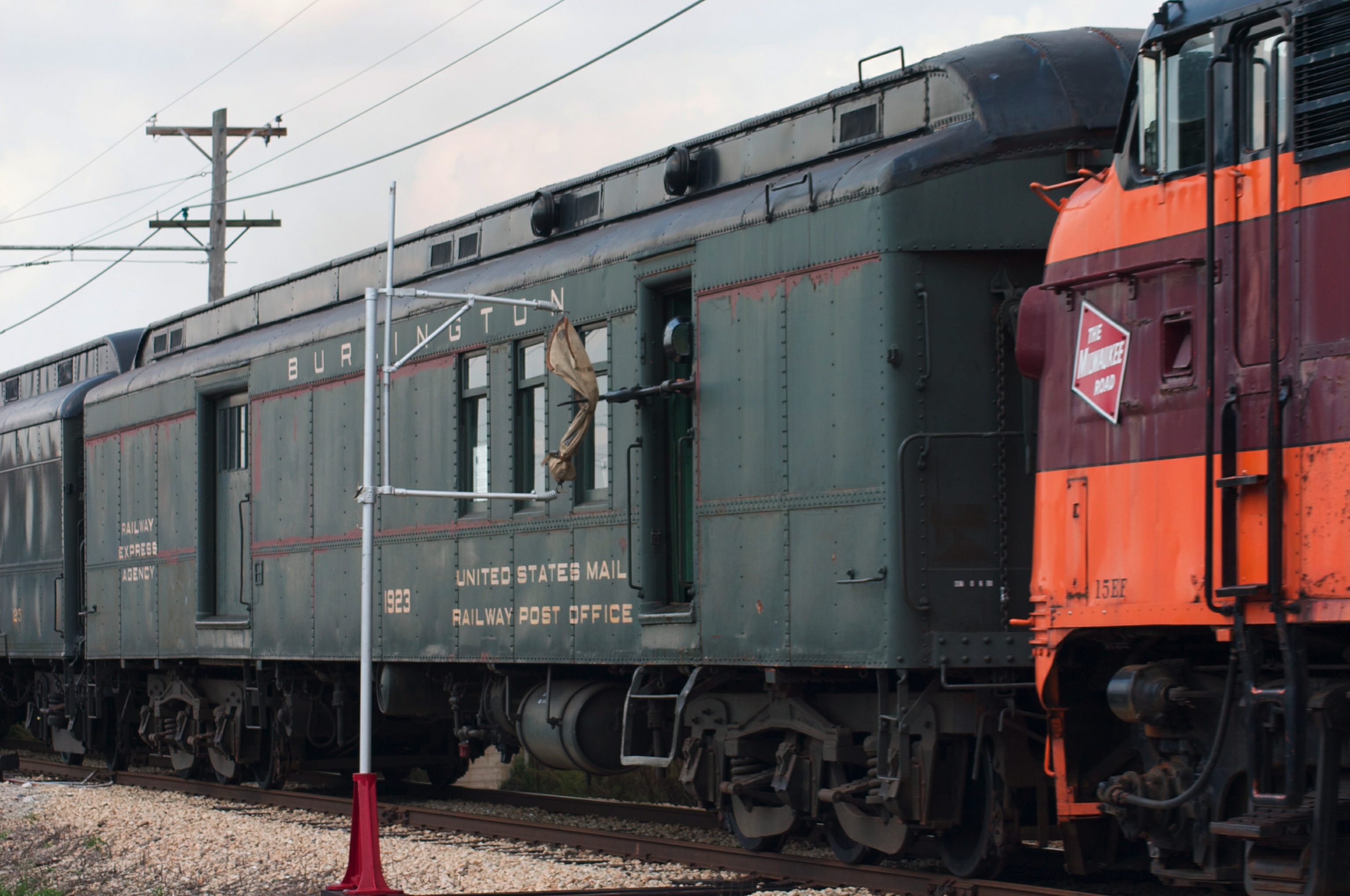|
M-10000
The M-10000 was an early American streamlined passenger trainset that operated for the Union Pacific Railroad from 1934 until 1941. It was the first streamlined passenger train to be delivered in the United States, and the second to enter regular service after the ''Pioneer Zephyr'' of the Chicago, Burlington and Quincy Railroad. Development The M-10000 car design built upon the efforts of William Bushnell Stout, an early designer of all-metal airplanes, who adapted fuselage design ideas to the ''Railplane'' (not to be confused with the '' Bennie Railplane''), a lightweight self-propelled railcar built by Pullman-Standard in 1932. The tapered car cross-section, lightweight tubular aluminum space frame construction, and Duralumin skin of the ''Railplane'' were carried over into the M-10000 design. The performance of the ''Railplane'' in testing drew the attention of Union Pacific, who sought the services of Pullman-Standard in building a small, lightweight streamlined trainset ... [...More Info...] [...Related Items...] OR: [Wikipedia] [Google] [Baidu] |
Streamliner
A streamliner is a vehicle incorporating streamlining in a shape providing reduced air resistance. The term is applied to high-speed railway trainsets of the 1930s to 1950s, and to their successor " bullet trains". Less commonly, the term is applied to fully faired upright and recumbent bicycles. As part of the Streamline Moderne trend, the term was applied to passenger cars, trucks, and other types of light-, medium-, or heavy-duty vehicles, but now vehicle streamlining is so prevalent that it is not an outstanding characteristic. In land speed racing, it is a term applied to the long, slender, custom built, high-speed vehicles with enclosed wheels. Trains Before World War II Europe * Germany, 1930: The first high-speed streamliner in Germany was the '' Schienenzeppelin'', an experimental propeller-driven single car, built in 1930. On 21 June 1931, the car set a speed record of on a run between Berlin and Hamburg. In 1932 the propeller was removed and a h ... [...More Info...] [...Related Items...] OR: [Wikipedia] [Google] [Baidu] |
Union Pacific Railroad
The Union Pacific Railroad is a Railroad classes, Class I freight-hauling railroad that operates 8,300 locomotives over routes in 23 U.S. states west of Chicago and New Orleans. Union Pacific is the second largest railroad in the United States after BNSF Railway, BNSF, with which it shares a duopoly on transcontinental freight rail lines in the Western United States, Western, Midwestern United States, Midwestern and West South Central states, West South Central United States. Founded in 1862, the original Union Pacific Rail Road was part of the first transcontinental railroad project, later known as the Overland Route (Union Pacific Railroad), Overland Route. Over the next century, UP absorbed the Missouri Pacific Railroad, the Western Pacific Railroad, the Missouri–Kansas–Texas Railroad and the Chicago, Rock Island and Pacific Railroad. In 1995, the Union Pacific merged with Chicago and North Western Transportation Company, completing its reach into the Upper Midwest. In ... [...More Info...] [...Related Items...] OR: [Wikipedia] [Google] [Baidu] |
Pioneer Zephyr
The ''Pioneer Zephyr'' is a diesel engine, diesel-powered trainset built by the Budd Company in 1934 for the Chicago, Burlington & Quincy Railroad (CB&Q), commonly known as the Burlington Route. The trainset was the second internal combustion-powered streamliner built for mainline service in the United States (after the Union Pacific Railroad's M-10000), the first such train powered by a diesel engine, and the first to enter revenue service. The trainset consists of one power/storage car, one baggage/Railway post office, RPO/buffet/coach car, and one coach/observation car. The cars are made of stainless steel, permanently articulated together with Jacobs bogies. The construction incorporated recent advances such as shotwelding (a specialized type of spot welding) to join the stainless steel, and unibody construction and articulation to reduce weight. It was the first of nine similarly built trainsets made for Burlington and its technologies were pivotal in the subsequent dieseliz ... [...More Info...] [...Related Items...] OR: [Wikipedia] [Google] [Baidu] |
M-10001
The Union Pacific Railroad's M-10001 was a Diesel-electric transmission, diesel-electric streamliner, streamlined train built in 1934 by Pullman-Standard with a power system developed by General Motors Corporation, General Motors Electro-Motive Diesel, Electro-Motive Corporation using a Winton 201A Diesel engine and General Electric Electrical generator, generator, control equipment and traction motors. It was the UP's second streamliner after the M-10000, their first equipped with a diesel engine and was a longer train (six cars) than its three-car predecessor. All cars were articulated—bogie, trucks were shared between each car. It was delivered on October 2, 1934, and was used for display, test and record-setting runs for the next two months before being returned to Pullman-Standard for an increase in power and capacity, following which it was placed into service as the ''City of Portland (train), City of Portland'' train. It has been nicknamed "The Banana". Record-setting r ... [...More Info...] [...Related Items...] OR: [Wikipedia] [Google] [Baidu] |
Electro-Motive Corporation
Electro-Motive Diesel (abbreviated EMD) is a brand of diesel-electric locomotives, locomotive products and diesel engines for the rail industry. Formerly a division of General Motors, EMD has been owned by Progress Rail since 2010. Electro-Motive Diesel traces its roots to the Electro-Motive Engineering Corporation, founded in 1922 and purchased by General Motors in 1930. After purchase by GM, the company was known as GM's Electro-Motive Division. In 2005, GM sold EMD to Greenbriar Equity Group and Berkshire Partners, and in 2010, EMD was sold to Progress Rail, a subsidiary of the heavy equipment manufacturer Caterpillar. Upon the 2005 sale, the company was renamed to Electro-Motive Diesel. EMD's headquarters and engineering facilities are based in McCook, Illinois, while its final locomotive assembly line is located in Muncie, Indiana. EMD also operates a traction motor maintenance, rebuild, and overhaul facility in San Luis Potosí, Mexico. As of 2008, EMD employed approximatel ... [...More Info...] [...Related Items...] OR: [Wikipedia] [Google] [Baidu] |
Jacobs Bogie
Jacobs bogies (named after Wilhelm Jakobs, 1858–1942, a German Mechanical engineering, mechanical Railway engineering, railway engineer) are a type of Rail transport, rail vehicle bogie commonly found on Articulated car, articulated railcars and Tram#Articulated, tramway vehicles. Instead of being underneath a piece of rolling stock, Jacobs bogies are placed between two carriages. The weight of each carriage is spread across the Jacobs bogie. This arrangement provides the smooth ride of bogie carriages without the additional weight and drag. Talgo#Design, Talgo trains use modified Jacobs bogies, that only use two wheels, and the wheels are allowed to spin independently of each other, eliminating hunting oscillation. Background The first fast train using this type of bogie was the German Fliegender Hamburger in 1932. In the United States, such configurations were used throughout the twentieth century with some success on early streamliner, streamlined passenger trainsets, such ... [...More Info...] [...Related Items...] OR: [Wikipedia] [Google] [Baidu] |
Traction Motor
A traction motor is an electric motor used for propulsion of a vehicle, such as locomotives, electric vehicle, electric or hydrogen vehicles, or electric multiple unit trains. Traction (engineering), Traction motors are used in electrically powered railway vehicles (electric multiple units) and other electric vehicles including electric milk floats, trolleybuses, elevators, roller coasters, and conveyor systems, as well as vehicles with electrical transmission systems (Diesel locomotive#Transmission types, diesel–electric locomotives, electric hybrid vehicles), and battery electric vehicles. Traction motor companies The word ''traction'' from Latin, being the Agent (grammar), agent noun of ''trahere'' "to pull" in the sense of "drawn" was used for the naming of traction engines developed circa 1870. The first experimental electric traction motor tramway of 1875 was rapidly developed internationally for city use. In the 19th century traction motor passenger car companies ... [...More Info...] [...Related Items...] OR: [Wikipedia] [Google] [Baidu] |
Diesel Motors
The diesel engine, named after the German engineer Rudolf Diesel, is an internal combustion engine in which Combustion, ignition of diesel fuel is caused by the elevated temperature of the air in the cylinder due to Mechanics, mechanical Compression (physics), compression; thus, the diesel engine is called a compression-ignition engine (CI engine). This contrasts with engines using spark plug-ignition of the air-fuel mixture, such as a petrol engine (gasoline engine) or a gas engine (using a gaseous fuel like natural gas or liquefied petroleum gas). Introduction Diesel engines work by compressing only air, or air combined with residual combustion gases from the exhaust (known as exhaust gas recirculation, "EGR"). Air is inducted into the chamber during the intake stroke, and compressed during the compression stroke. This increases air temperature inside the Cylinder (engine), cylinder so that atomised diesel fuel injected into the combustion chamber ignites. The torque a dies ... [...More Info...] [...Related Items...] OR: [Wikipedia] [Google] [Baidu] |
Railway Post Office
In Canada and the United States, a railway post office, commonly abbreviated as RPO, was a railroad car that was normally operated in passenger service and used specifically for staff to sort mail en route, in order to speed delivery. The RPO was staffed by highly trained Railway Mail Service postal clerks, and was off-limits to the passengers on the passenger train, train. From the middle of the 19th century, many American railroads earned substantial revenues through contracts with the United States Post Office Department, U.S. Post Office Department (USPOD) to carry mail aboard high-speed passenger trains. The Railway Mail Service enforced various standardized designs on RPOs. A number of railway companies maintained nominally unprofitable passenger routes, having found that their financial losses from moving people were more than offset by transporting the mail on such passenger routes. History The world's first official carriage of mail by rail was by the United Kingdom of ... [...More Info...] [...Related Items...] OR: [Wikipedia] [Google] [Baidu] |
Franklin Delano Roosevelt
Franklin Delano Roosevelt (January 30, 1882April 12, 1945), also known as FDR, was the 32nd president of the United States, serving from 1933 until his death in 1945. He is the longest-serving U.S. president, and the only one to have served more than two terms. His first two terms were centered on combating the Great Depression, while his third and fourth saw him shift his focus to America's involvement in World War II. A member of the prominent Delano and Roosevelt families, Roosevelt was elected to the New York State Senate from 1911 to 1913 and was then the assistant Secretary of the Navy under President Woodrow Wilson during World War I. Roosevelt was James M. Cox's running mate on the Democratic Party's ticket in the 1920 U.S. presidential election, but Cox lost to Republican nominee Warren G. Harding. In 1921, Roosevelt contracted a paralytic illness that permanently paralyzed his legs. Partly through the encouragement of his wife, Eleanor Roosevelt, he ret ... [...More Info...] [...Related Items...] OR: [Wikipedia] [Google] [Baidu] |
Bogie
A bogie ( ) (or truck in North American English) comprises two or more Wheelset (rail transport), wheelsets (two Railroad wheel, wheels on an axle), in a frame, attached under a vehicle by a pivot. Bogies take various forms in various modes of transport. A bogie may remain normally attached (as on many railroad cars and semi-trailers) or be quickly detachable (as for a dolly (trailer), dolly in a road train or in railway bogie exchange). It may include Suspension (vehicle), suspension components within it (as most rail and trucking bogies do), or be solid and in turn be suspended (as are most bogies of continuous track, tracked vehicles). It may be mounted on a swivel, as traditionally on a railway carriage or locomotive, additionally jointed and sprung (as in the landing gear of an airliner), or held in place by other means (centreless bogies). Although ''bogie'' is the preferred spelling and first-listed variant in various dictionaries, bogey and bogy are also used. Rail ... [...More Info...] [...Related Items...] OR: [Wikipedia] [Google] [Baidu] |








